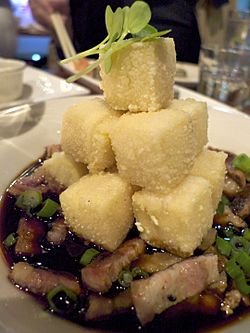Tokwa't baboy facts for kids

Tokwa't Baboy served at a fine dining restaurant
|
|
| Type | Appetizer, snack |
|---|---|
| Course | Hors d'oeuvre |
| Place of origin | Philippines |
| Region or state | Cavite |
| Serving temperature | Warm, room temperature |
| Main ingredients | Pork ears, pork belly, tofu Dip: soy sauce, pork broth, vinegar, white onions, scallions, red chili peppers |
| Variations | See kinilaw |
| Similar dishes | Sisig |
Tokwa't baboy is a popular Filipino dish. Its name comes from the Tagalog words "tokwa" (tofu) and "baboy" (pork). The "t" in the middle means "and." So, it literally means "tofu and pork."
This tasty dish is often served as a snack. It can also be a side dish with rice porridge. Sometimes, people eat it with plain rice as a meal.
What is Tokwa't Baboy?
Tokwa't baboy is a mix of different ingredients. It usually has deep-fried tofu. It also includes parts of pork. These pork parts are often pork ears and pork belly.
How is it Made?
The pork parts are usually boiled until tender. Then, they are chopped into small pieces. The tofu is cut into cubes and deep-fried until golden.
All these ingredients are mixed together. They are served in a special sauce. This sauce is made from soy sauce, vinegar, and pork broth. It also has chopped white onions, scallions, and red chili peppers. The chili peppers give it a little spicy kick!
How is it Eaten?
Tokwa't baboy is often served as pulutan. This is a Filipino word for "finger food" or snacks. People usually eat pulutan while having drinks with friends or family. It's also a great side dish for lugaw or arroz caldo. These are types of Filipino rice porridge.
Where Did it Come From?
The idea for tokwa't baboy comes from an older dish. This older dish is called kulao or kilawin na tainga ng baboy. It means "raw pig's ear" in the Caviteño Tagalog language. This dish is a type of kinilaw. Kinilaw dishes are made by cooking meat or seafood in vinegar or citrus juice.
Because of this history, tokwa't baboy is sometimes called kilawing tokwa't baboy. It shows how the dish has changed over time. It started as a pork-only dish and later added tofu.
See also
 In Spanish: Tokwa’t baboy para niños
In Spanish: Tokwa’t baboy para niños

